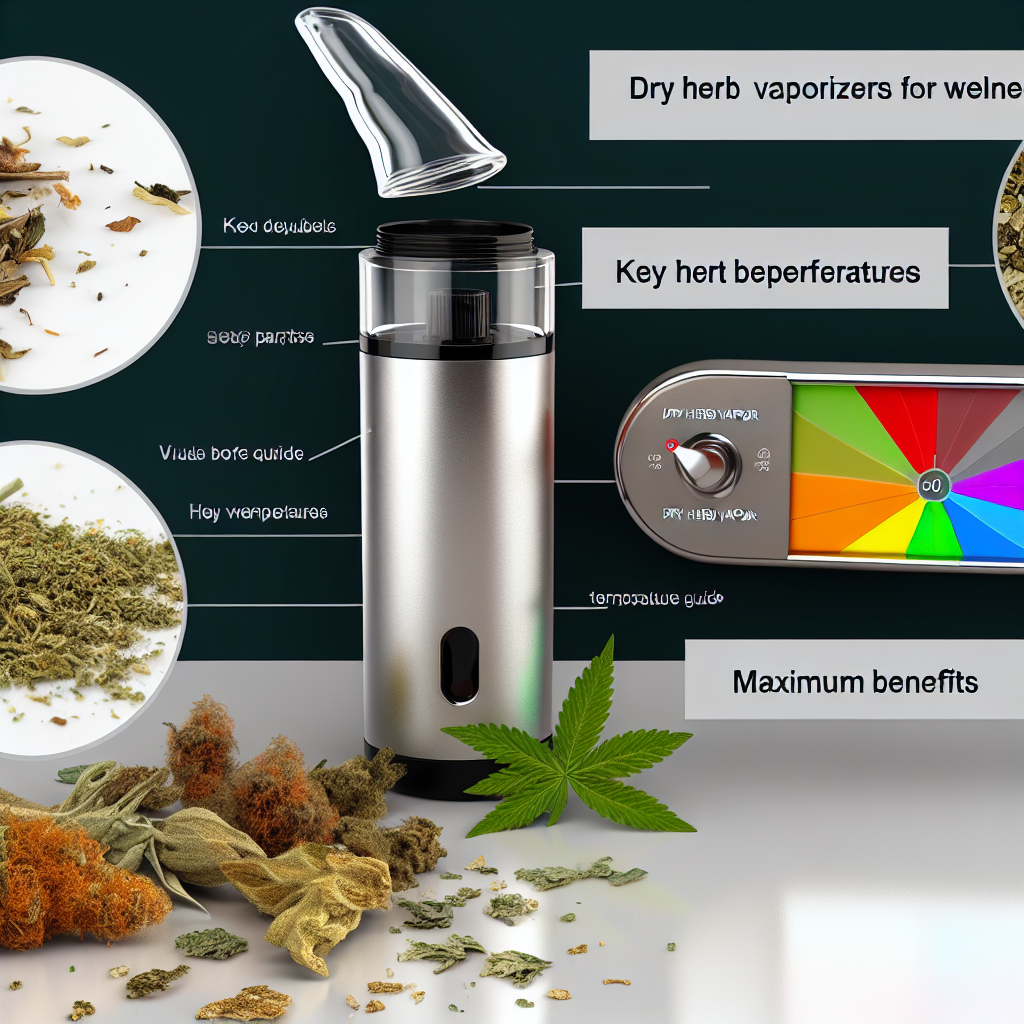# Dry Herb Vaporizers for Wellness: Temperature Guide for Maximum Benefits
Introduction: Elevating Health with Heat, Not Smoke
In recent years, the cannabis landscape has evolved far beyond simple smoking. As both recreational users and medical cannabis patients seek healthier alternatives, dry herb vaporizers have surged in popularity—and for good reason. Unlike combustion, which can release harmful toxins and carcinogens, vaporization heats cannabis flower to specific temperatures, releasing therapeutic cannabinoids and terpenes without burning the plant material. This method provides a cleaner and often more effective experience, making it an essential tool for wellness-oriented consumers.
For medical marijuana users, choosing the right vaporizer temperature can make all the difference in managing conditions like anxiety, chronic pain, inflammation, or insomnia. Similarly, recreational users who are mindful about their experience—looking to feel relaxed without brain fog or energized without anxiety—can benefit immensely from mastering the temperature spectrum. Each cannabinoid and terpene vaporizes at different temperatures, and by targeting these ranges, users can fine-tune their cannabis journey to maximize therapeutic effects.
As awareness grows around cannabis as a wellness tool, so does the interest in optimizing its consumption. Whether you’re microdosing for daily focus or looking for nighttime relief, understanding dry herb vaporizer temperatures can help extract the most benefit from each session. With a growing body of scientific support and more consumer-friendly technology entering the market, using temperature-controlled vaporizers offers both precision and predictability in every dose.
This article will explore the science behind cannabis vaporization, highlighting the optimal temperature ranges for specific wellness goals. We’ll delve into peer-reviewed studies, health implications, and terpene profiles, guiding you to make more informed decisions about how—and why—you vape. Whether you’re a healthcare provider recommending cannabis to patients or a seasoned enthusiast on your wellness journey, this temperature guide will provide a fresh perspective on how dry herb vaporizers can elevate both effect and safety.
The Science of Heat: Why Temperature Matters in Cannabis Vaporization
The phenomenon behind cannabis vaporization lies in the diverse heating points of its active compounds. While combustion happens around 451°F (233°C)—leading to the release of toxins like benzene and tar—vaporization occurs at far lower temperatures, generally between 320°F (160°C) and 430°F (221°C). Understanding these ranges is key to unlocking targeted effects for therapeutic use.
Low Temperatures (320°F to 340°F): For Clarity, Uplift, and Mellow Vibes
📈 **Best for:** Focus, mood elevation & mild symptom relief
At the lower end of the spectrum, users primarily vaporize terpenes like pinene and limonene. These compounds are known for energizing, mood-enhancing, and anti-inflammatory effects.
– **Limonene**: Anxiolytic and immune-boosting
– **Pinene**: Enhances alertness and memory retention
According to the [2011 study by Russo](https://www.ncbi.nlm.nih.gov/pmc/articles/PMC3165946/), limonene may help alleviate stress, making this range ideal for individuals new to cannabis or those looking to stay productive while medicated. This range also allows for mild THC activation (~315°F), providing gentle euphoria without overwhelming psychoactivity.
Medium Temperatures (340°F to 390°F): Balance Between Body and Mind
🧘 **Best for:** Pain relief, inflammation control & moderate relaxation
This mid-range unlocks a larger array of therapeutic benefits, making it the sweet spot for both medical users and experienced enthusiasts. Here, you begin to activate additional cannabinoids:
– **CBD (~356°F)**: Anti-inflammatory, neuroprotective, and anxiolytic
– **CBG & CBN**: Helpful for GI issues, nerve pain, and sleep regulation
A [2017 review by Pisanti et al.](https://www.ncbi.nlm.nih.gov/pmc/articles/PMC5938896/) highlights CBD’s potential to reduce seizures, improve sleep quality, and mitigate chronic pain—benefits that become prominent in this vaporization zone.
This range also offers a richer terpene profile, providing the entourage effect without over-sedation. Ideal for daytime use with therapeutic benefits.
High Temperatures (390°F to 430°F): Deep Relief and Sedation When You Need It Most
🌙 **Best for:** Insomnia, PTSD, chronic conditions & heavy symptom management
Now we enter the therapeutic powerhouse range.
– **CBN**: Sedative, sleep-inducing
– **THCV**: May reduce appetite and help with metabolic regulation
– **Myrcene**: Widely believed to enhance sedation
This zone delivers noticeably stronger effects—beneficial for those coping with insomnia, PTSD, chemotherapy side effects, or MS. However, it’s crucial to stay under 430°F to avoid combustion and toxin formation.
A [2007 study by Abrams et al.](https://www.ncbi.nlm.nih.gov/pmc/articles/PMC1853081/) found that vaporization provides rapid cannabinoid absorption while minimizing harmful by-products. For patients prioritizing lung health, vaporization—especially at these higher temperatures—is a safer alternative to smoking.
How to Personalize Your Vaping Journey: Tech Tips for Tailored Wellness
Modern vaporizers are designed to let users take control. Devices from industry leaders like **Storz & Bickel**, **PAX**, and **Arizer** provide precise temperature control, user-friendly displays, and even app connectivity.
🔁 **Try “Temperature Stepping”**
Begin your session at a lower temp to enjoy uplifting terpenes, then gradually raise the temperature to access heavier cannabinoids and maximize your herb. This strategy allows you to experience the full spectrum of therapeutic compounds, all in one session.
🔍 **Pro Tips for Best Results**
– Use high-quality, well-cured dry herb
– Grind herbs finely for even heat distribution
– Clean your device regularly to preserve flavor and function
– Store your cannabis in airtight containers away from light and moisture
Conclusion: Enhance Your Wellness with the Power of Temperature
Dry herb vaporizers have emerged as a leading method for cannabis consumption, particularly for those prioritizing wellness. From focus and serenity to deep relaxation and symptom relief, vaporizer temperatures can be fine-tuned to match your personal goals.
As scientific understanding grows around cannabinoids and terpenes, your ability to personalize cannabis therapy expands with it. With a bit of data, the right device, and mindful use, dry herb vaporization becomes more than a method—it becomes your wellness ritual.
## References
1. Russo, E. B. (2011). Taming THC: potential cannabis synergy and phytocannabinoid-terpenoid entourage effects. *British Journal of Pharmacology.* [Link to article](https://www.ncbi.nlm.nih.gov/pmc/articles/PMC3165946/)
2. Pisanti, S. et al. (2017). Cannabidiol: State of the art and new challenges for therapeutic applications. *Frontiers in Neurology.* [Link to article](https://www.ncbi.nlm.nih.gov/pmc/articles/PMC5938896/)
3. Abrams, D. I., Vizoso, H. P., Shade, S. B., Jay, C., Kelly, M. E., & Benowitz, N. L. (2007). Vaporization as a smokeless cannabis delivery system: A pilot study. *Clinical Pharmacology & Therapeutics.* [Link to article](https://www.ncbi.nlm.nih.gov/pmc/articles/PMC1853081/)
Concise Summary (100 words):
Dry herb vaporizers offer a healthier alternative to smoking cannabis, allowing users to fine-tune their experience by targeting specific temperature ranges. Lower temperatures (320°F-340°F) activate uplifting terpenes like limonene and pinene, providing focus and mild relief. Mid-range temps (340°F-390°F) unlock more therapeutic cannabinoids like CBD, ideal for pain management and moderate relaxation. Higher temps (390°F-430°F) deliver deeper sedation and relief for conditions like insomnia and chronic pain. By understanding the science behind vaporization, users can personalize their cannabis journey to maximize wellness benefits while prioritizing safety and lung health.




